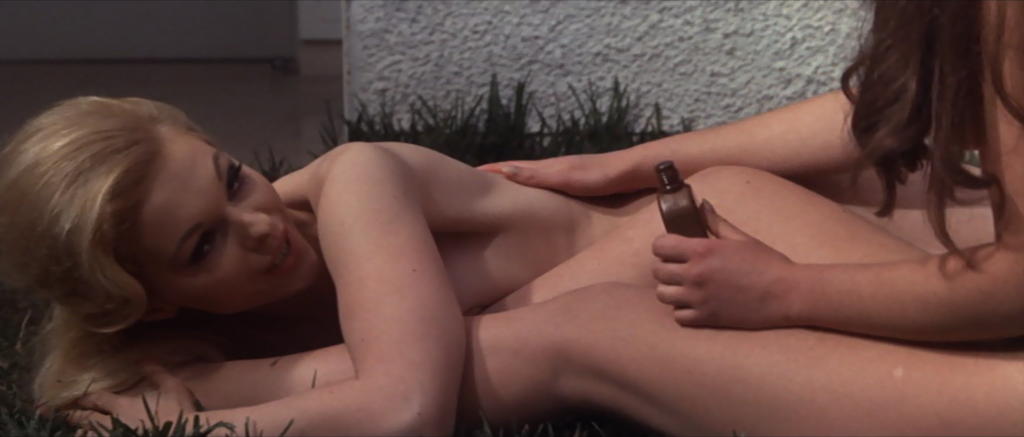
De Sade 70 (1970) or Eugenie… The Story of Her Journey into Perversion is Jesús Franco’s second film adaptation of a work by the Marquis de Sade. For a long time I used to confuse this film with Eugenie de Sade (1973) which, coincidentally, was shot in the same year as De Sade 70 and released later. Franco’s output is so extensive that it isn’t easy keeping track of all of his films. Typically only his best films, like Eugenie de Sade, are the ones most clearly recalled.
Harry Alan Towers script for De Sade 70 takes the Maquis de Sade’s La philosophie dans le boudoir and opens up the physical scope of the text to include an entire private island as well as moving the story to a contemporary setting. La philosophie dans le boudoir is a dramatic dialogue which gave Franco a free hand to conjure images to accompany what pieces of the text that he saw fit to retain. The political and social commentaries in La philosophie dans le boudoir have been jettisoned to privilege the pornographic elements. Of all of Franco’s famed adaptations of de Sade’s work for the screen only a very few bother to do more than titillate.
De Sade 70 is a typical film for Franco at this time. Of course the influence of Orson Welles can be felt in some of the more sensual images but they never attain the sexual agency or technical ingenuity that made Vampyros Lesbos (1970) and She Killed In Ecstasy (1970) masterpieces of genre filmmaking. De Sade 70 reserves the occasional visual flourish for the most debauched scenes and those haunting shots of Maria Rohm on the beach.
Marie Liljedahl plays Eugenie, a young virgin being tutored in the arts of pleasure by Madame Saint Ange (Rohm) for the pleasure of her master Dolmance (Christopher Lee). De Sade 70 is a tail of virtue tested and ultimately spoiled; a spectacle of female submission. Liljedahl is good enough as the naive teenager but De Sade 70 really belongs to Maria Rohm. The cool, icy and calculated manner that Rohm brings to her part is as erotic as it is frightening. Rohm’s eyes are so emotive and charismatic that she’s able to suggest a complexity to her character that the superior actor Christopher Lee is unable to do with his extremely limited screen time.
Whole legends about Lee and Franco have arisen from the production of De Sade 70. The two had worked together before on three films in 1969, including Franco’s acclaimed Count Dracula. De Sade 70 isn’t like those earlier films though. This film is a soft-core picture which Lee claimed he didn’t know when he replaced George Sanders after shooting began. What animosity there ever was between the two men stems from this misunderstanding. However, in typical movie fashion, things have been blown out of proportion with various retellings over the years.
One of the singular aspects of De Sade 70 that I have always thoroughly enjoyed is the score by Bruno Nicolai. Nicolai was at the height of his powers during this period and his jazz fusion soundtrack is an inspired mix of pop and avant-garde sensibilities. The Digitmovies CD release of Nicolai’s recordings for De Sade 70 is an incredible compilation of cues from those used to those never before released.
Now, getting back to the film itself, where does one rank De Sade 70 in Franco’s epic oeuvre? De Sade 70 is truly classic Franco, featuring some of his regular players and some of the best collaborators that he ever worked with. As far as an introduction to the most famous auteur of euro-sleaze I wouldn’t recommend starting here. If there’s a weakness to all of Franco’s films it’s his pacing and De Sade 70 can feel downright glacial at times. De Sade 70 is a solidly mediocre outing elevated by Maria Rohm and Bruno Nicolai.
